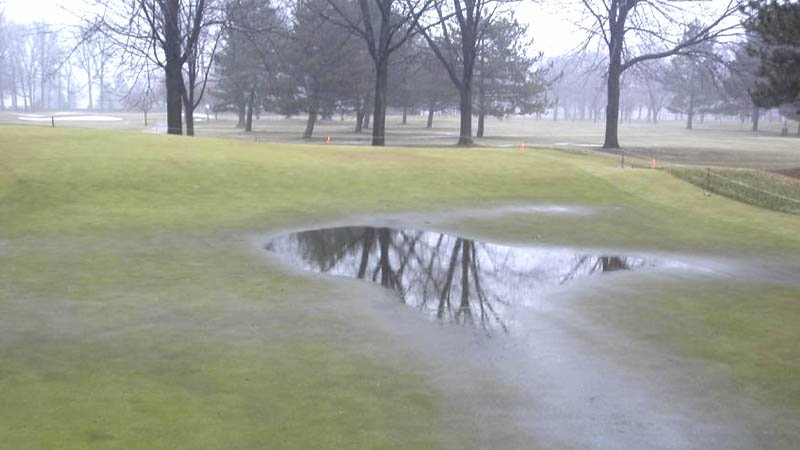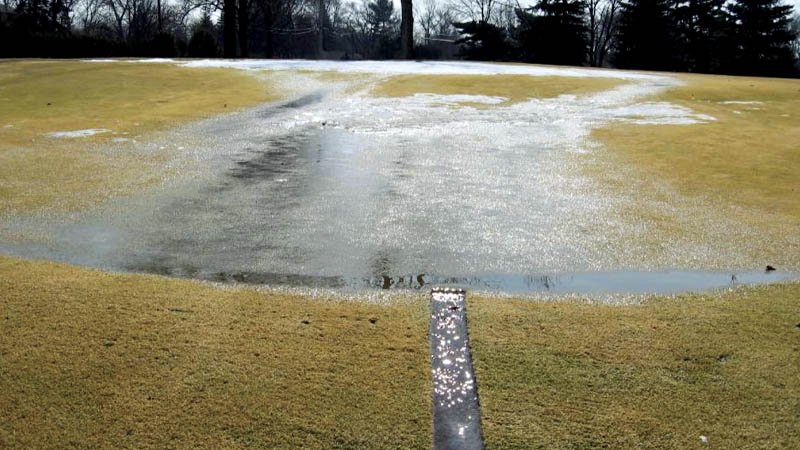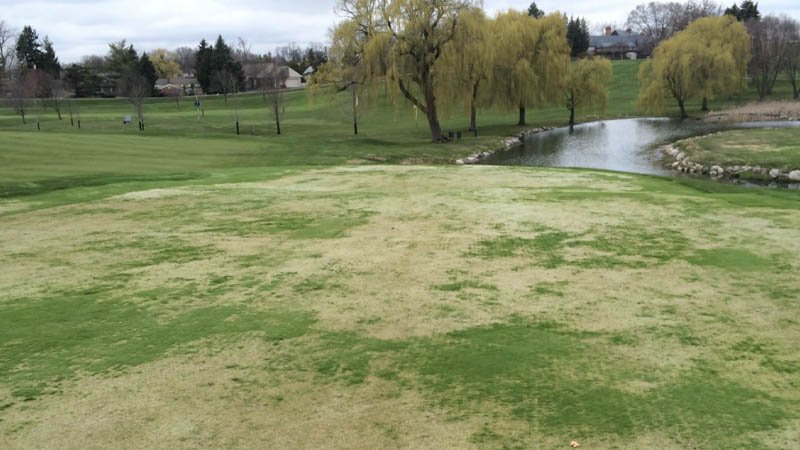
Winter usually is a time when superintendents can look forward to taking a little time away from the golf course. However, it also is time to be aware of the threat of winter damage in both cool- and warm-season turf.
Although there are distinct differences in winter damage in cool- and warm-season turf, one thing that is common to both is plants that already are weakened are the most susceptible to damage. Examples of at-risk areas are those where drainage is poor or where heavy shade is an issue. A pair of recent TurfNet webinars by Kevin Frank, Ph.D., of Michigan State University and Wendell Hutchens, Ph.D., of the University of Arkansas, addressed winterkill in both cool- and warm-season grasses
While winter damage on cool-season turf typically is associated with ice cover, warm-season turf is susceptible simply to extreme low temperatures. Hutchens points to December 2022 as an example when an overnight drop in temperature from the high 30s to below zero caused havoc throughout Arkansas.
"That extreme event pretty much wiped out a lot of our warm-season grasses in Arkansas and surrounding areas," Hutchens said during a recent TurfNet webinar on preventing winterkill in warm-season turf.
"This extreme low temperature can cause direct kill to warm-season grasses, and that is what we saw in the winter of '22."
Causes of winterkill in warm-season turf include:
- extreme low temperatures
- sustained low temps that leads to carbohydrate exhaustion
- rapid temperature drop in late fall or early spring
- desiccation caused by too little soil moisture
- anoxia caused by too much soil moisture
Managing moisture, height of cut and nitrogen in the fall helped prevent winter damage on warm-season turf, according to Hutchens. His advice for preventing winter damage is based largely on results from a multi-year study he and others conducted in Virginia and Maryland from 2019 to 2023.
The study was conducted on Tahoma 31, Latitude 36, Tufcote and Tifway 419, from 2019 to 2023 at outdoor and indoor locations.
Results of the study showed that late-season applications of slow-release nitrogen can help retain fall color without compromising cold hardiness through winter. The research also showed that increasing fall mowing height in fairway turf from 0.5 inches to 0.75 inches helped with color retention and reduced the incidence of winter weed growth.

Irrigating dormant warm-season turf during times of prolonged drought (two weeks or more) through winter can help prevent desiccation, a major cause of winterkill.
In Hutchens' research, plots were irrigated to levels less than 15 percent volumetric water content and more than 19 percent VWC. Results showed that irrigation at the higher rate and applications of wetting agents before short-term freeze events reduced winter injury.
He also suggested use of permeable covers on greens for periods of sudden temperature drops or sustained cold periods.
Winter damage in cool-season turf typically manifests as desiccation or crown hydration injury associated with ice cover.
Michigan State's Frank has written and talked extensively on the subject of winterkill. He also suggests use of permeable covers to prevent desiccation or exposure to severe cold temperatures, but adds that covers are not always effective during periods of prolonged ice cover, a major cause of winterkill in annual bluegrass.
Annual bluegrass can show signs of winter damage after just 30 days or less under ice cover and is especially at risk after continued periods of thawing and refreezing. Creeping bentgrass is more tolerant to ice cover, and might not show signs of damage for up to 120 days.

"All of our estimates for killing turf are just that, estimates," Frank said in his webinar on winterkill. "It could be 45-90 days in some cases. Injury could occur in 30 days for annual bluegrass. In some cases, annual bluegrass has damage in less than 30 days."
Frank's keys for preventing winterkill in cool-season turf are:
- improve surface drainage
- increase mowing height
- promote plant health
- monitor for ice
Good drainage is key to preventing winter damage in warm- and cool-season grass.
Frank suggests cutting cup cutter-sized holes in areas with poor drainage and filling the holes with gravel or sand. He also suggests cutting channels to facilitate moving water off greens when snow and ice melt to prevent damage during a refreeze.
He also suggests fall fertilization and slightly raising height of cut on greens going into winter to promote improved plant health.
In 2020, Michigan State began using sensors to record soil and air temperatures at three depths, oxygen and carbon dioxide levels and relative humidity. The goal is to develop what Frank called a warning system that conditions are right for winter damage.
"It's not only understanding the conditions that cause winterkill," Frank said, "but then what also are the specific measures that kill (turf), because right now, to be honest, it's always a little bit of guesswork of our own experiences and opinions sprinkled in with some science that we know about for getting these diagnoses correct."

